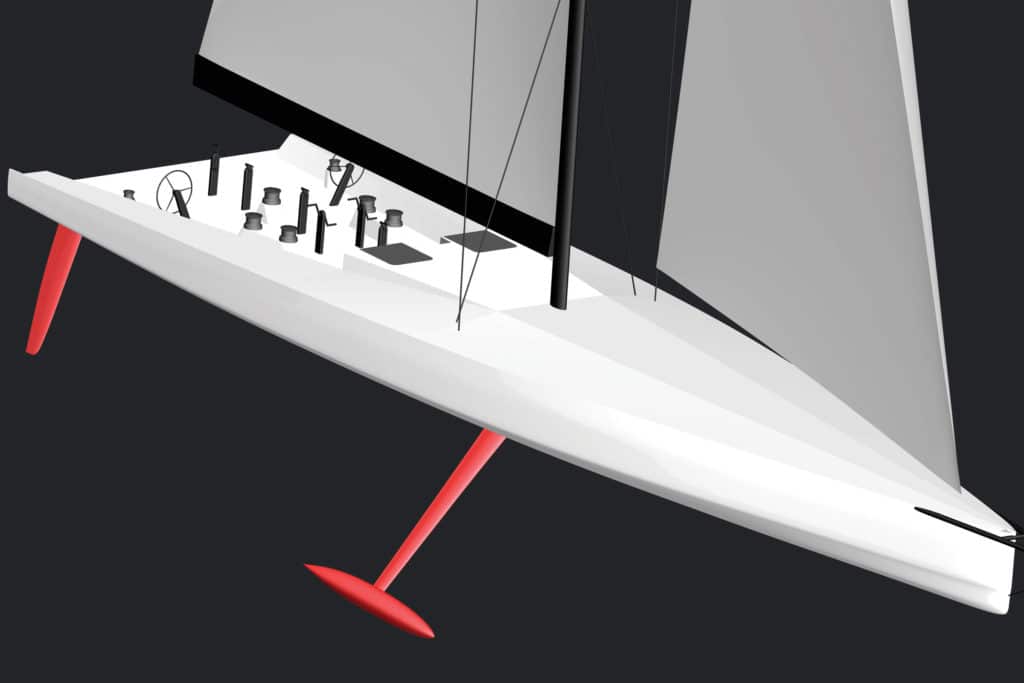By early fall of 2014, if all goes according to their respective plans, we will be standing in awe of two incredible, state-of-the-art, canting keel, record-setting machines built right here in America. These boats will be two bold and very different visions from two powerful men who seek nothing but to feed their appetite for assembling complicated and technical programs designed to perform beyond the performance-sailing status quo. These owners do it for passion and to make history. They know that with the right preparation, and a little luck, goals and challenges are there to be taken. At the end of the day, it’s about shattering existing records, being the first boat to finish, and winning races with an exclamation point.
Avid yachtsman Jim Clark is leading one program, and the boat is under construction at Hodgson Shipyard in Maine. I’m quite close to this program because I started sailing with him right after the last Volvo Ocean Race, so I have a pretty good handle on why it’s being built.
Clark, of famed business start-ups Netscape and Silicon Graphics, has owned many famous mega yachts, but this will be his very first flat-out raceboat. Compare this 100-foot carbon-fiber maxi to any of his existing boats and you’ll see about as remarkable a difference as sailing can offer.
Hanuman is Clark’s extremely successful J Class replica of Endeavour II. At 137 feet and nearly 180 tons, I suspect that its wood interior, and all the artwork displayed onboard, is as heavy as the new boat itself.
“I’ve closely watched the Volvo and other point-to-point races and started thinking that record breaking may be a fun thing to tackle,” Clark told me when he finally decided to pull the trigger on this project. “Then came my exposure to the Rolex Sydney Hobart Race. Kristy, my wife, is from Australia and has always had an affinity for that race, like all Australians. Combine her interest with good-natured ribbing from my friend Neville Creighton [owner of the 100-footer Alfa Romeo] to ‘join the party and build a 100 footer’ … I threw my hat in the ring.”
Clark’s boat is a cooperative design effort by design firms Verdier Naval Architecture and VPLP. These two companies have had amazing success in multihulls and the IMOCA 60 Class, mainly boats for shorthanded racing. But this is a different animal. As a fully-crewed monohull for specific courses, the new super maxi is being built right to the limit of the length-overall rules for most big offshore races. Unlike almost every other boat of its kind, Clark’s new ride will have manual winches in order to be able to break conventional records, such as the transatlantic record, without having an asterisk because of powered winches.
If one new super maxi isn’t enough in the U.S., how about another shot at a record breaker. This second program, for George David, is being kept under tighter wraps, but the buzz around the waterfront is really starting to ramp up as details leak from the build shed.
David’s Rambler program is well known. He’s owned a series of boats named Idler and Rambler, and his current Rambler is a 90-foot water-ballasted rocket that owns more elapsed-time records than I bet he can recall. It’s a spectacular boat, and over the many years of racing he’s nurtured an equally spectacular crew capable of continually raising the bar in big-boat sailing. But the new boats now emerging are faster, and the Rambler team knows it’s time to step up.
In 2012, David chartered the 100-foot super maxi Speedboat from American owner Alex Jackson, and campaigned the boat for nearly a year. The campaign ended dramatically when the keel broke off within miles of Fastnet Rock. David and his wife, Wendy, were separated from the boat when it capsized. They were finally found after more than two and a half harrowing hours in the water. The boat was scrapped, only to be later bought by Australian Anthony Bell and completely rebuilt to race the 2013 Rolex Sydney Hobart Race as Perpetual Loyal.
A lesser man would have said enough is enough but not David, who has teamed up with designer Juan Kouyoumdjian and New England Boat Works, in Portsmouth, R.I. I’m told the boat is like a Volvo 70 on steroids. Kouyoumdjian wrote the book on how to design such boats. It’s supposed to be big, but nobody is saying how big.
One point of debate about boats of this scale is whether a super maxi really has to be right at the 100-foot maximum limit or not. Certain races, such as the Fastnet, the Sydney Hobart, and the Middle Sea Race restrict entries to monohulls less than 100 feet in length. With modern engineering and construction, however, there’s an argument to be made that the weight of supporting a sail plan with a reasonable amount of stability is prohibitive when you get too big, and that there may be a design “sweet spot” that’s less than 100 feet. This will be one of the many intriguing observations when these two new boats hit the water.
When, and if, these boats will meet up is unclear. Both were in production in early February, but nothing happens fast when building complicated carbon-fiber raceboats. Clark’s launch is slated for fall 2014, and David’s possibly a bit earlier. One thing for certain, however, is that barring any major teething issues, Clark will dispatch his new boat almost directly to Australia for the Sydney Hobart Race to tangle with seven-time winner Wild Oats XI. These new yachts are going to be a sight to behold.
This article first appeared in the March/April 2014 issue of Sailing World. Click here to read more from Ken Read’s column, Gaining Bearing.










